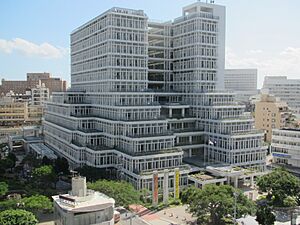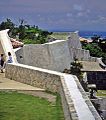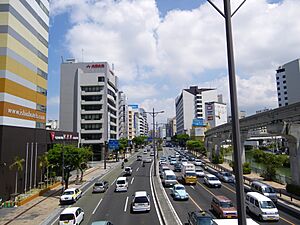Naha facts for kids
Quick facts for kids
Naha
那覇市
|
|||||||||||
|---|---|---|---|---|---|---|---|---|---|---|---|

From top left: Shuri Castle, Shureimon, Kokusai dōri, Kinjocho Ishidatami-michi, Central Naha
|
|||||||||||
|
|||||||||||
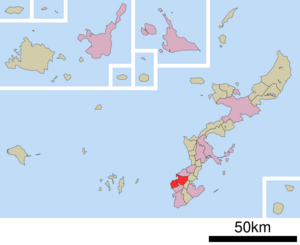
Location of Naha in Okinawa Prefecture
|
|||||||||||
| Country | Japan | ||||||||||
| Region | Kyushu (Ryukyu) | ||||||||||
| Prefecture | Okinawa Prefecture | ||||||||||
| First official recorded | 1322 | ||||||||||
| Special district Settled | 1896 | ||||||||||
| City Settled | May 20, 1921 | ||||||||||
| Area | |||||||||||
| • Core city | 39.98 km2 (15.44 sq mi) | ||||||||||
| • Urban | 478.57 km2 (184.78 sq mi) | ||||||||||
| Population
(March 1, 2024)
|
|||||||||||
| • Core city | 312,099 | ||||||||||
| • Density | 7,806.4/km2 (20,218.4/sq mi) | ||||||||||
| Time zone | UTC+9 (Japan Standard Time) | ||||||||||
| Phone number | 098-867-0111 | ||||||||||
| Address | 1-1-1 Izumizaki, Naha-shi 900-8585 | ||||||||||
| Climate | Cfa | ||||||||||
|
|||||||||||
Naha (那覇市, Naha-shi, Japanese: [naꜜha], Okinawan: Nāfa or Nafa) is the capital city of Okinawa Prefecture, which is the southernmost part of Japan. As of June 1, 2019, about 317,405 people live in Naha. It is a busy city with many people living close together. The total area of Naha is about 39.98 square kilometers (15.44 square miles).
Naha is located on the coast of the East China Sea, on the southern part of Okinawa Island. This is the largest island in Okinawa Prefecture. The city we know today was officially started on May 20, 1921. But even before that, Naha was a very important and busy place in Okinawa for hundreds of years.
Naha is the main center for government, business, and education in Okinawa Prefecture. Long ago, during the time of the Ryukyu Kingdom, it was the most important place for trade.
Contents
Exploring Naha City
Naha is a lively city with many interesting places to visit. It has modern shopping areas and historical sites.
Heart of Naha: Shopping and Fun
The central part of Naha includes the Palette Kumoji shopping mall, the Okinawa Prefecture Office, and Naha City Hall. You'll also find many banks and businesses here. This area is at the west end of Kokusai-dōri, which is the city's main street.
Kokusai-dōri (国際通り, "International Avenue") is a long street, about 1.6 kilometers (1 mile) long. It's full of stores, restaurants, and places to eat. Kokusai-dōri ends at the main bus station in Okinawa. You can also get there by using the Okinawa Urban Monorail, which is the only train system in Okinawa.
Off Kokusai-dōri, you can find the Heiwa-dōri Shopping Arcade, which is covered. There's also the Makishi Public Market. This is a huge market filled with fresh fish, meat, and vegetables. You can also find restaurants, souvenir shops, and places to buy drinks. Close to the market is the Tsuboya (壺屋, "pot/jar shop") area. This place was once famous for making pottery.
New Metropolitan Center
Northeast of Kokusai-dōri is a newer business area called Shintoshin (新都心, "New Metropolitan Center"). This area used to be housing for the United States military. It became available to Okinawa in 1987, but big changes and building only started in the mid-1990s.
Omoromachi Station is connected to a fancy shopping mall. Another mall, Naha Main Place, is a short walk away. It has many high-end Western fashion stores, restaurants, and other shops. This area is popular with young people. It has big stores like Toys R Us and Best Denki (an electronics store), a co-op market, many restaurants, and a movie theater.
The Okinawa Prefectural Museum opened here in November 2007. It shows the art, history, and nature of the Ryukyu Islands. It is located in front of Shintoshin Park.
City Neighborhoods
Naha is made up of many different neighborhoods. One of the old areas, Shuri, is still a part of the city today.
Naha's Rich History
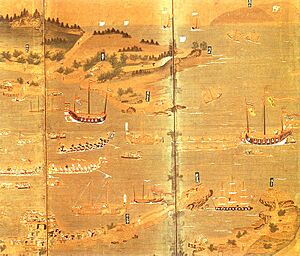
The name Naha might come from its original name, Naba. This was the name of a large, mushroom-shaped stone in the city. Over time, the stone wore away, and the name changed to Naha.
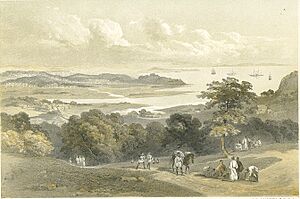
Archaeologists have found old items from the Stone Age in Naha. They even found ancient Chinese coins in a shell mound from the Jōmon period. Pottery found here shows that the area was trading with Japan and Korea as early as the 11th century. Naha became an important port city by the early 15th century, when the Ryūkyū Kingdom was formed.
In the past, Naha was a smaller city. It was known as a major port, but not as the main political center. The royal capital was in Shuri. Today, Naha has grown to include Shuri and other nearby towns.
During the time of the Ryūkyū Kingdom, Naha was on a small island called Ukishima. It was connected to Okinawa Island by a narrow path called Chōkōtei, which led to Shuri. The main port for international trade was divided into East and West areas. There was a big outdoor market and a trading center. Japanese temples and shrines were also located here. Two forts, Mie gusuku and Yarazamori gusuku, protected the harbor.
Tomari (泊), located northeast of Ukishima, was the main port for trade within the Ryūkyū Islands. The people in charge of Tomari also collected and managed the tribute (payments) sent to the kingdom from the Amami Islands.
The community of Kumemura was a center for Chinese learning in Ryūkyū for many years. It's believed that 36 Chinese families from the Ming Chinese Imperial Court started Kumemura. However, because Naha was so important for international trade, many other Chinese people likely settled there too.
On the northwest side of Ukishima was Wakasamachi (若狭町, "Wakasa town"). This community is traditionally said to have been started by Japanese settlers. It had Japanese shrines and temples, including the Naminoue Shrine.
Over time, the water areas separating Ukishima (Naha) from Okinawa Island were filled in. The neighborhoods of Kume, Wakasa, and Tomari are still part of Naha today.
In 1853, American ships led by Commodore Matthew C. Perry visited Naha on their way to Tokyo. Drawings made by the expedition's artist showed the geography and people of the Ryūkyū islands to the world.
After the Ryūkyū Kingdom became the Ryūkyū Domain in 1872, Naha became its capital. In 1879, Japan fully took over the Ryūkyū Kingdom, making it Okinawa Prefecture. Naha remained the capital city. Shuri and other nearby towns became part of Naha.
In July 1899, Naha was made an open port for trade with the United States and the United Kingdom.
During World War II, Naha was badly damaged in the battle of Okinawa. The entire city center had to be rebuilt. On September 1, 1954, the village of Oroku joined the city.
On April 1, 2013, Naha became a "core city" in Japan. This means it can handle many public services that would normally be managed by the prefectural government. Naha was the first core city in Okinawa Prefecture.
Naha's Culture and Traditions
Beliefs and Shrines
Naha has many shrines and temples, from small huts to large buildings. The local beliefs are a mix of Shintoism, Buddhism, Taoism, and old local traditions. A very visible part of Okinawan beliefs are the shiisaa ("lion dogs"). These are thought to protect the island and can be seen everywhere: on walls, roofs, windows, and in parks.
The Cathedral of the Immaculate Heart of Mary (Kainan Church) is an important church for Roman Catholics in Naha.
Festivals and Events
Naha has exciting festivals throughout the year:
- Naha Hari: A dragon boat event held in May.
- Naha Festival: A big celebration in October.
- Naha Tug-of-war: A famous and very large tug-of-war event.
Famous Places to See
Shuri Castle is one of the most important historical sites in Naha. It was the royal palace of the Ryūkyū Kingdom. The castle was almost destroyed in 1945 during World War II. After the war, the University of the Ryūkyūs was built there. Today, Shuri Castle has been rebuilt, including its famous main gate, Shureimon. It is now a UNESCO World Heritage Site, along with other important Okinawan historical places.
Lake Man, which has mangrove trees, is located on the border of Naha and Tomigusuku. It is listed on the Ramsar Convention as an important wetland.
-
Shuri Castle, Seiden - front facade
-
Walls of Shuri Castle in Naha
Learning and Education
There are four universities in the Naha area. Two are run by Okinawa Prefecture, and two are private. The University of the Ryukyus, the only national university in Okinawa, used to be at Shuri Castle. It moved to Nishihara before the castle was rebuilt.
Naha's public elementary and junior high schools are managed by the Naha City Board of Education. Public high schools are managed by the Okinawa Prefectural Board of Education. There are also private schools, like the Okinawa Actors' School.
Martial Arts in Naha
Naha-te (meaning "Naha-hand") is a type of martial art that was developed in Naha. Some well-known styles of karate that came from Naha-te include Gōjū-ryū, Uechi-ryū, Ryūei-ryū, and Tōon-ryū.
Naha's Climate
Naha has a humid subtropical climate. This means it has hot summers and mild winters. It rains a lot throughout the year, with September being the wettest month and December being the driest.
Summers in Naha are hot and humid. July and August are the warmest months, with average high temperatures over 31 degrees Celsius (88°F). Winters are warm, with average high temperatures in January and February around 19-20 degrees Celsius (66-68°F). The average low temperatures are around 14-15 degrees Celsius (57-59°F). Naha gets a lot of rain, usually more than 2000 mm (79 inches) per year.
| Climate data for Naha (1991−2020 normals, extremes 1890−present) | |||||||||||||
|---|---|---|---|---|---|---|---|---|---|---|---|---|---|
| Month | Jan | Feb | Mar | Apr | May | Jun | Jul | Aug | Sep | Oct | Nov | Dec | Year |
| Record high °C (°F) | 27.0 (80.6) |
27.1 (80.8) |
28.2 (82.8) |
30.6 (87.1) |
32.0 (89.6) |
34.3 (93.7) |
36.0 (96.8) |
35.6 (96.1) |
34.6 (94.3) |
33.0 (91.4) |
31.6 (88.9) |
29.4 (84.9) |
36.0 (96.8) |
| Mean daily maximum °C (°F) | 19.8 (67.6) |
20.2 (68.4) |
21.9 (71.4) |
24.3 (75.7) |
27.0 (80.6) |
29.8 (85.6) |
31.9 (89.4) |
31.8 (89.2) |
30.6 (87.1) |
28.1 (82.6) |
25.0 (77.0) |
21.5 (70.7) |
26.0 (78.8) |
| Daily mean °C (°F) | 17.3 (63.1) |
17.5 (63.5) |
19.1 (66.4) |
21.5 (70.7) |
24.2 (75.6) |
27.2 (81.0) |
29.1 (84.4) |
29.0 (84.2) |
27.9 (82.2) |
25.5 (77.9) |
22.5 (72.5) |
19.0 (66.2) |
23.3 (73.9) |
| Mean daily minimum °C (°F) | 14.9 (58.8) |
15.1 (59.2) |
16.7 (62.1) |
19.1 (66.4) |
22.1 (71.8) |
25.2 (77.4) |
27.0 (80.6) |
26.8 (80.2) |
25.8 (78.4) |
23.5 (74.3) |
20.4 (68.7) |
16.8 (62.2) |
21.1 (70.0) |
| Record low °C (°F) | 6.1 (43.0) |
4.9 (40.8) |
6.3 (43.3) |
8.7 (47.7) |
11.0 (51.8) |
14.8 (58.6) |
20.8 (69.4) |
20.7 (69.3) |
17.0 (62.6) |
14.8 (58.6) |
8.6 (47.5) |
6.8 (44.2) |
4.9 (40.8) |
| Average precipitation mm (inches) | 101.6 (4.00) |
114.5 (4.51) |
142.8 (5.62) |
161.0 (6.34) |
245.3 (9.66) |
284.4 (11.20) |
188.1 (7.41) |
240.0 (9.45) |
275.2 (10.83) |
179.2 (7.06) |
119.1 (4.69) |
110.0 (4.33) |
2,161 (85.08) |
| Average precipitation days (≥ 0.5 mm) | 12.2 | 11.3 | 12.6 | 11.6 | 13.1 | 12.4 | 11.0 | 13.9 | 13.3 | 10.6 | 9.6 | 10.7 | 142.0 |
| Average relative humidity (%) | 66 | 69 | 71 | 75 | 78 | 83 | 78 | 78 | 75 | 72 | 69 | 67 | 73 |
| Mean monthly sunshine hours | 93.1 | 93.1 | 115.3 | 120.9 | 138.2 | 159.5 | 227.0 | 206.3 | 181.3 | 163.3 | 121.7 | 107.4 | 1,727.1 |
| Source: Japan Meteorological Agency | |||||||||||||
Naha's Economy and Transport
City's Economy
Naha is the main business hub of Okinawa. Its economy mostly relies on tourism, shopping, and service industries. Okinawa's biggest banks, like Bank of the Ryukyus and Bank of Okinawa, have their main offices in Naha. Many international insurance companies also have call centers here.
Getting Around Naha
Naha Airport and Naha Port are very important for travel in and out of the city. Naha Airport is the main airport for Okinawa Prefecture.
The Okinawa Urban Monorail, also called the Yui Rail (ゆいレール), helps people travel around Naha. It connects Naha Airport to the city center, Kokusai-dōri, Shintoshin, Shuri, and goes all the way to Tedako-Uranishi Station in Urasoe.
The Tomari wharf in Naha is where ferries leave to connect Okinawa Island to other nearby islands. You can take a daily ferry to Kagoshima on the mainland of Japan. There are also smaller ferries to the Kerama Islands, like Tokashiki, Aka, and Zamami.
Naha's Global Connections
Naha has special connections with other cities around the world, called "twin towns" or "sister cities." This helps build friendships and understanding between different places.
Naha is twinned with:
 Fuzhou, China (since 1981)
Fuzhou, China (since 1981) Honolulu, United States (since 1961)
Honolulu, United States (since 1961) Kawasaki, Kanagawa, Japan (since 1996)
Kawasaki, Kanagawa, Japan (since 1996) Nichinan, Miyazaki, Japan (since 1969)
Nichinan, Miyazaki, Japan (since 1969) São Vicente, Brazil (since 1978)
São Vicente, Brazil (since 1978) São Paulo, Brazil
São Paulo, Brazil
Famous People from Naha
Many well-known people have connections to Naha, including:
- Yui Aragaki, a singer, actor, and model
- Namie Amuro, a pop singer
- Kurara Chibana, a model and beauty queen who was Miss Japan 2006
- Cocco, a singer
- Gichin Funakoshi, a famous karate master
- Eriko Imai, a pop singer, actor, and politician
- Kazuki Ganaha, a football (soccer) player
- Kanryō Higaonna, a martial artist
- Morio Higaonna, a karate master
- Ankō Itosu, a karate master
- Chōjun Miyagi, a martial artist who started the Gōjū-ryū school of karate
- Fumi Nikaidō, an actor and model
- Orange Range, an alternative rock band
- Dave Roberts (outfielder), a major league baseball player and manager
- Mitsutoshi Shimabukuro, a manga artist
- Mikiko Shiroma, a politician and former mayor of Naha
- Norihiro Yagi, a manga artist
- Sho Yonashiro, a singer
Naha in Movies and Games
Naha City has appeared in many popular movies, TV shows, and video games:
- The 1986 film The Karate Kid Part II was set in Naha, but it was actually filmed in Hawaii.
- The beginning of David Mitchell's 1999 novel Ghostwritten takes place in Naha.
- In the 2003 space game Freelancer, there's a gas mining station named "Naha."
- Shuri Castle was recreated in the 2008 video game Call of Duty: World at War. Players help capture the castle in the final part of the American story.
- Parts of Naha were carefully recreated in 3D for the 2009 video game Ryu ga Gotoku 3 (known as Yakuza 3 in North America). This virtual version includes Kokusai-dōri, the Heiwa-dōri Shopping Arcade, Makishi Public Market, and the Monorail's Prefectural Office Station.
- The TV show Anthony Bourdain: Parts Unknown visited Okinawa to try Okinawan food and learn about the history of Karate.
- The PBS series Family Ingredients filmed episodes in Naha and Okinawa, including at Shuri Castle and Makishi Market.
- The Karate Kid spin-off Cobra Kai filmed parts of its third season in Naha and other areas of Okinawa Island, including Naha Airport.
See also
 In Spanish: Naha para niños
In Spanish: Naha para niños





